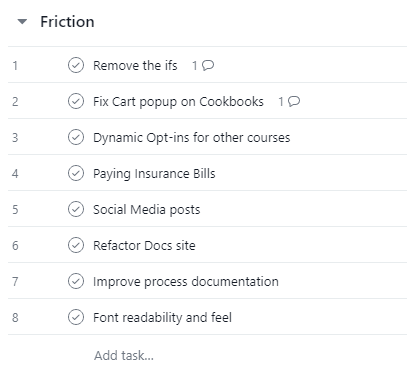The Friction List
Created: January 4, 2021
Consistency and efficiency are noble goals for any team. It sounds like a dream; smooth, quiet, stress-free operation.
Commonly in English, we'll use the phrase "runs like a well-oiled machine" to
describe something that operates consistently and efficiently. A quick search
of run like a machine shows well over one billion hits, many of which are
posts and articles about how to make your business/team/service "run like a
well-oiled machine." I certainly want my life and my business to operate that
way. Perhaps you, too, want your team to operate like a well-oiled machine.
Here's the catch:
Someone actually has to do the oiling.
In order to run consistently at peak performance, those "well-oiled machines" need routine maintenance, frequent health checks, and a lot of intentional care. Without those things, friction begins to build up. That friction will wear down the machine's components and gradually erode its precious consistency and efficiency. It's an insidious, slow decline - you're too busy one week to investigate that weird noise, or it's crazy around here and that gear isn't squeaking that loudly - and then all at once. A delay in one project pushes back another project yet again, which sets off the frustrated client, which is the tipping point for a developer to finally throw up their hands and quit, and another one quickly follows in the uncertain aftermath.
Just like that, your machine is destroyed, and unlike actual machine parts, you can't run down to the store to find replacements or grab one on Amazon. People are uniquely irreplaceable; they aren't plug-and-play. If your team members are easily replaceable, then you're hiring the wrong people.
If you want to get closer to that dream of a well-oiled machine, an onboarding program like we've been discussing is a great foundation, and you're going to need to perform regular maintenance on your machine. One way I like to do that:
Use a Friction List
- Create a list of Friction Points - everything you find annoying, time-consuming, troublesome, or more difficult than it "should" be in your team's operations.
- Make the list visible, accessible to, and editable by everyone on the team.
- Encourage each individual to add their own Friction Points to the list.
- This is not a static list; whenever you come across a sticking point in your processes, quickly add it to the list.
- Plan "Friction Reduction" alongside your normal project work; include at least one Friction Point into every iteration/sprint/unit of work.
- Use project downtime to tackle additional Friction Points.
- Periodically perform a brief Friction Review to add new Friction Points and drop irrelevant ones.
Just for kicks, here's the Friction List from my own business at the time of this writing:
They're unrelated tasks of varying sizes that annoy me or impede me in some way in having the business I want. They're tasks that don't otherwise have a home under normal business operations or client work. Whenever something annoys me, I add it to the list. Whenever I find myself with a bit of downtime and no pressing task, instead of doom-scrolling Twitter or checking email unnecessarily, I pop open my Friction List - which I have bookmarked for fast accessibility - and chip away at whatever strikes my fancy in the moment. A month ago, that list had twice as many items on it.
Frequent, small cleanups will keep the machine running extremely well as well as make the periodic deep cleanings easier and more effective. By making your list and opening it up to the team, you encourage everyone to participate in the ongoing maintenance of your well-oiled machine; you increase their investment in improving the machine with you, and you make it well-known that it's OK to identify problems, raise concerns, and share ideas. That's how you build a culture of engineering, and a culture of engineering is one that builds well-oiled machines.
HTH
-EG
P.S. I'd love to hear about your onboarding process in this brief survey.
